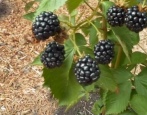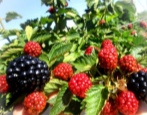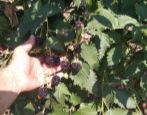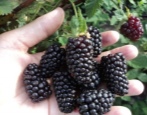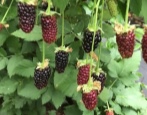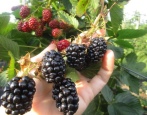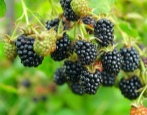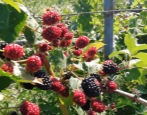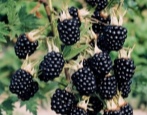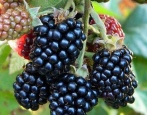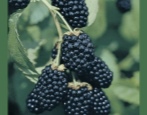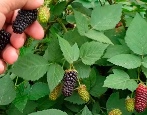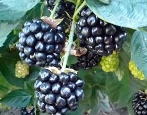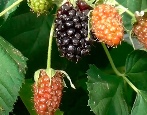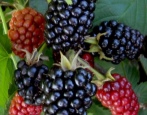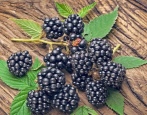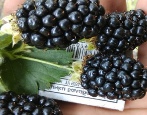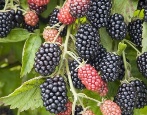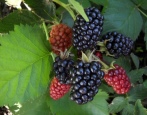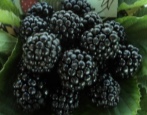
- Authors: United Kingdom
- Taste: sweet with sourness
- Scent : fruity
- The presence of thorns: No
- Berry weight, g: up to 8
- Berry size: large
- Berry color: black
- Fruiting period: mid June - end of July
- Yield: 15 kg per bush
- Frost resistance, ° C / Winter hardiness: winter hardy, -30 С
A very early hybrid of the Loch Tei blackberry, in many garden parameters, it is distinguished by advantageous characteristics. That is why he received quick recognition among gardeners in various countries. But its main advantage was its high resistance to various diseases and pest attacks.
Breeding history of the variety
Loch Tay is a hybrid blackberry crop created by breeders from Scotland by cross-pollination of Loch Ness and SCRI 82417D. According to other sources, this happened by crossing a logan berry with a raspberry. The resulting variety with juicy and tasty berries turned out to be unpretentious. Since 2011, the shrub has been cultivated in Russia, since it quickly attracted the attention of gardeners from various regions of the country with its unpretentiousness and productivity.
Description of the variety
The bushes of the culture are semi-creeping, rapidly developing, reaching a height of 4-5 m. Shoots are smooth, thornless, light brown shades. Leaves are carved, jagged, thick, leathery, emerald tones. The shoots germinate when the root system is damaged. Inflorescences include 10-12 flowers of light shades, small in size. The fruits are large, the berries are black, shiny, with a hard structure.
The root system is branched, powerful, capable of collecting a significant amount of trace elements, protecting the bushes from diseases of viral or fungal origin. Highly resistant to drought.
Ripening terms
Fruiting of the culture starts one year after planting. The first harvest does not differ in abundance. The bush reaches the highest yield in 4-5 years of growth. The ripeness of the berries depends on the specific climatic conditions of the growing region. In warm regions, the harvesting of fruits begins at the end of July, and in the northern and temperate latitudes, the dates are shifted by 2-3 weeks. The fruit ripening process takes 3-4 weeks.
Yield
From one bush Loch Tei get up to 15 kg of fruit, but even more for 5 years of life. With proper agricultural care, the yield increases by another 2-3 kg.
Berries and their taste
The fruits are large - the weight of one berry reaches 12 g. The fruits are cylindrical or conical in shape. The berry has a deep black or emerald hue and a typical blackberry gloss. The skin is thin, silky, and has elasticity. Loch Tei has a sweet taste with light refreshing sourness and fruity notes.
The taste of the fruit is sweet and rich. The berries are juicy, exuding pleasant forest aromas. The dense structure of the fruit allows for reliable transportation of the crop.
Growing features
For planting, one-year seedlings with a height in the range of 20-40 cm are purchased. The presence of buds and lateral branches with ovaries is mandatory.
Before planting, pits are made, with a depth and diameter of 30-40 cm. They are usually located at a distance of 2.5-3 m for easy care in the future. At the same time, a special useful mixture is prepared, consisting of humus and ash. Or they use mineral fertilizers containing potassium, boron, phosphorus, nitrogen and others.
Before planting, the holes are watered, and after absorbing water, the seedling is dug in so that the growth bud is located at a depth of no more than 3 cm.After planting, watering follows again - about 1.5-2 buckets per bush. In conclusion, apply a layer of mulch (3-5 cm) of sawdust, peat, bark, dried grass. To stimulate growth, prune to a height of 30-40 cm.
Competent care includes a number of typical activities and procedures: watering, pruning, organizing trellis support, shelter for the winter and feeding.
The culture is drought-resistant, and therefore drip irrigation is good (before that, low-lying branches are raised, tying them up at a height of 50 cm). This type of irrigation provides access to 15 liters of water per bush. Watering is carried out in the evenings or in the morning 1 time in 2-3 weeks.
When watering, it is important to be careful during flowering and ripening of fruits, since excess watering often leads to soil decay. Finishing watering in a year is carried out two weeks before the bushes are sheltered for the winter.
Crop shoots can lean towards the ground, which negatively affects the bushes, complicating the care and collection activities. To avoid this, they organize a trellis system up to 2 m high, with a stretched wire. Blackberry branches are attached to the wire at a height of about 1.5 m.
Site selection and soil preparation
The place for disembarkation is selected taking into account the degree of humidity and illumination. In a culture, roots grow deeper into the ground than in raspberries, and therefore the level of concentration of groundwater should be controlled, allowing it to be located at a depth of at least 2 m. The southern, southwestern or southeastern sides of the plots are perfectly suited for the degree of illumination. Slightly acidic or neutral soils are preferable. The soil is suitable if chamomiles and field bindweed grow on it.
As for the quality of the soil, the culture is undemanding to it. Nevertheless, excellent yields are noted on high-quality aerated lands supplied with organic matter.
Bushes should not be planted after nightshade crops and strawberries. Cereals and legumes are considered good predecessors for them. They begin to prepare the site in the fall - they remove plant residues, dig it to a depth of about 40 cm. Then they disinfect it with a 3% solution of copper sulfate. Consumption - 1 liter per 10 m². After a week, the digging is repeated to a depth of 20 cm, feeding the soil with manure (20 kg per 1 m²), 10 kg of sand, 120 g of superphosphate and 60 g of calcined salt.
Frost resistance and preparation for winter
As for the cold weather, the degree of stability of the culture is average - the bushes tolerate winter well at temperatures not lower than –20 ° С. Therefore, in cold areas, shelter for the winter is necessary. To do this, use spruce branches, dry grass, fallen leaves and more. The thickness of a cover layer of 10-15 cm is quite enough. In this case, the bushes are certainly removed from the trellis devices 12-14 days before the cold snap. The branches are tilted to the ground, fixing them with staples, and then they are already covered with spruce branches or agrofibre, sprinkling with a layer of soil up to 10 cm high.After the snow melts in the spring, the shelters are removed, and the branches are again hung on the trellises.
Diseases and pests
The variety has excellent immunity, but it is worth remembering that the possibility of diseases really exists, as well as pest attacks. Among the possible diseases of Loch Tei, diseases of anthracnose, verticillus and botrytis are noted.
With anthracnose, purple specks appear on the leaves, and gray ones on the stems. The spots have a red border. In case of manifestations of the disease, the bushes are covered with compost from peat, manure and soil (3: 1: 1 or 2: 1: 2) during the processing of row spacings.
When infected with verticillosis, the leaves turn yellow and dry. For the purpose of treatment, fumigation with tobacco or sulfur is carried out (in calm weather).
Botrytis is characterized by manifestations of gray rot on berries. To cure, blackberries are treated with a solution of potassium nitrate.
In addition, the Loch Tei blackberry is sometimes attacked by the raspberry beetle, shoot aphid and weevil.
Reproduction
The variety is propagated by digging in the tops, as well as by deliberately damaging the root system with a shovel so that the bushes give root shoots. From the beginning of July, they pick up several twigs of one year old, press them to the soil, pinning the tops, and then fill them with 10 cm of soil.During the season, they carry out typical care, as for adult plants. In the spring, next year, the finished seedling is removed from the plant and transplanted to the right place.
In the second method of reproduction, the emerging basal shoots are dug up and planted in a prepared place.


